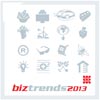[2013 trends] From data to honesty, it's getting personal
![[2013 trends] From data to honesty, it's getting personal](https://biz-file.com/c/1301/122801.jpg)
- Honesty
- Pop-ups
- Content, content, content
- 'Freecommerce'
- Big data gets personal
- Mobile
- Shoptimisation - technology, apps and business practices are making shopping quicker, easier and more convenient. Not convinced? Visit Slice, Dashlane, GoodRx, ShopSavvy, Wish Want Wear, Key Ring, Rent the Runway or Macy's in-store GPS
- Peer-to-peer communities are on the rise
- MeFunding - personal crowdfunding brands such as GoFundMe, indiegogo and GiveForward allow individuals to raise money for everything from life-changing trips to paying for medical bills after an accident.
- Hyperlocal commerce - The likes of Goodzer, Sears Local, Popularise, Fundrise and Shopify are driving hyper-localisation, where users instantly create e-commerce sites and apps that allow them to keep money in their community.
- FriendSourced travel - airbnb, Vayable, trippy, Dine with the Dutch, and Tripbirds all allow your friends to inspire your travel plans via a suite of apps and new travel services.
- Visual social media
- Fashion designer Kahri-Anne Kerr uses visual social media sites such as Pinterest and Facebook to market her Kahri collection. "When I post pictures on Facebook, they get the most feedback of all my posts," says Kahri. "Visual media is a great way to share more about what inspires the designs, as well as linking to your online store and straight product shots."
- Designer brand Moleskine has created one of the world's most active, prolific, and creative online communities, powered by user-generated content.
2012's strikes - from Marikana to De Doorns - have unearthed fault lines in the South African psyche. Aside from the political, economic and social perspectives, which have been discussed to death, the issue of brand honesty has come to the fore, a trend which mirrors global movements.
Honesty is increasingly viewed (by strategists and pundits, at least) as an essential brand requirement in the 21st century economy. With everyone doing business in glass houses, the desire to present a perfect brand face to the world has been rendered irrelevant. Honesty has been forced upon us all, because presenting the perfect face is simply no longer possible.
Brands are being forced to move from the verbiage of transparency (talking about values, in other words) to demonstrating values and ethos through transparent behaviour. Credentials must be proven, not spoken about.
Pop-up stores reflect the compounding mobility of our economic lifestyles. They also extend the shopping experience beyond a particular time and place, and enhance the brand's ability to boost stimulation of the consumer's senses.
Shopping is steadily becoming a more wide ranging, sensory and experiential affair. Magnum, for example, created the 'Infinity Pleasure Pod' in London just before the summer Olympics. Shoppers within the pod were measured biochemically as they ate an Infinity Bar. Skin tension, facial expression, heart rate and other measured data were used to create an animated representation of the experience - which Magnum tagged the 'pleasure portrait', to shoppers' delight.
Similarly, Mattel/Walmart created a 3D Pop-Up Toy Shop during Canada's 2012 holiday shopping season. The combination of 3D walls and QR codes allowed the brands to boast that it was changing the basic meaning of window shopping. Sears and Kmart have also used 'shoppable' walls in the recent past.
SA's 2012 pop-up prize goes to the Puma Social Club in Braamfontein, Johannesburg. 'The meeting point for the after-hours athlete' says the strapline.
Many brands have tried and failed over the years to force their way into the middle of the Jozi urban youth market. Play energy drink, for example, spent a great deal of time and effort with its Griffin Sessions and Play Heroes in 2012, via a campaign which sought to identify and augment the core ethos of the young city scene. Despite all Play's efforts, however, Puma has been the brand on all young city lips.
Why? Puma kept it all disarmingly simple and created a cool, fun space for everyone. From Foosball sessions to quick impromptu six song sets from the likes of the Blk Jks, the Puma Social Club opened its doors, and people came. No secret venues, no over-elaborate positioning devices. Just a place for people to chill out.
The lesson? Pop-ups are inherently fun. Stick to the fun basics and much can be achieved.
Brands have the tools to create communities, reshape their own narratives and place themselves at the centre of trends, and content. Global heavy hitters such as Red Bull and Nike provide best practice examples on how to position a brand in the centre of a community that generates content via happy instinct.
Red Bull achieves this through a wide range of activities, from DJ Battle events through to extreme sports (all supported by Red Bull TV, the Red Bull Magazine, etc), while Nike has been very successful combining events such as Run Jozi with a strong social media presence. Both brands literally own their content creation - to the envy of many others around the world.
With authenticity being a watch word for the average consumer, and honesty the watchword for the average brand, a major content creation challenge looms. Brands looking to operate in this space will need to consistently improve their storytelling skills, to the point where the gap between who the brand thinks it is and who the consumer thinks it is, is authentically narrow.
But creating authentic content streams is not child's play, by any means (just ask Media24, which recently shut down its content marketing arm). The problem is the fragmented nature of digital communication, where the number of niche, specialised content segments seems to compound overnight. Developing a large-scale, one-size-fits-all approach to the content challenge simply doesn't work, even if you have the backing of big corporate budgets.
In 2013 (and beyond), look out for the proliferation of niche content agencies with the ability to deliver volume and quality, within tightly defined demographic segments.
Where once e-commerce was a strategically and technically scary land, where only high powered geeks roamed, now anyone can sign up for a free e-shop at a site such as www.ecwid.com.
And if you want full integration with your Facebook page, you just install the Facebook app. Fancy some new music? You can cruise Soundcloud.com for days listening to, and downloading, mixes and arrangements and original compositions from across the world. If you want to make your own beats, there are free music software packages online, and the same goes for Photoshop equivalents and pretty much everything else. Need a website? Just use Wix.
Beyond the cloud and software, 'freecommerce' is taking root in other important areas. Zando.co.za has shaken the local e-commerce market with free delivery of its shoes and fashion merchandise. Free music is also a global trend that keeps on coming. In just one example, musician Amanda Palmer's new album, "Theatre is Evil", is available free, or at any price a fan wants to pay.
The converse of the emergence of free music is contract-based streaming. The likes of Simfy are attempting to march us towards a world where we simply stream directly from the cloud to our cellphones and other devices.
Freemium pricing structures are also on the rise. Here, the initial product - a game or an app, for example - is offered available free, but the upgrades and improvements are charged. The level of addiction to the product defines the success of the pricing model (and we all know how addictive some of those clickables can be!).
At the simplest level, Big Data refers to our collective ability to process huge sets of data, mined on the digital frontier. Big Data can be crunched using complex algorithms and data-processing tools to produce new insights on all sorts of things - from medical research to shopping behaviour patterns to social media trends.
In a world where consumers expect, without even really thinking about it, personalised, relevant communication, Big Data allows an organisation to use the power of mass communication while staying in touch with the individual's wants and needs in a way that would have been unthinkable a few years ago.
From the brand's perspective, an engineered union between technology and marketing is an important point of focus, but in the consumer's mind the line between technology and marketing is fading very fast. We expect personalised, targeted and relevant communication at all touch points. And we expect it now.
Thus, brands able to create a highly personal experience within the framework of an automated system are well on the path to 21st century growth, and loyalty.
The view of the world from Internet Explorer, Google Chrome or Firefox is still very relevant, but a whole new communication universe has opened up beyond the browser, in the form of apps. In the early years, apps were gaming-, media- and GPS-focused, but now we're moving toward personalised apps that seek to understand the user's behaviour, and support it accordingly.
One notable example is the rise of DIY health, where diagnostic and treatment processes are managed by the patient, via an app. With over 13 000 health apps already in the Apple app store alone, the big bridge for the user to cross is credibility and reliability.
As a result, we can expect doctors, clinics, insurance brands and other medical role players to begin making their presence felt with certifications and validations, as well as by developing apps themselves. Appscriptions can potentially reduce medical costs, improve compliance and allow for the kind of remote medical monitoring that improves broad societal health.
At the moment, the field may appear like something for other people, but the underlying trend of a society moving decisively toward mobile service delivery is going to impact everyone, eventually.
Other important mobile trends:
Where once users would write many words on social media platforms about their experiences, advances in mobile technology (Instagram is a key player here) make it far easier now to take a picture and upload it. Brands such as Pinterest and Twitter have powered this dynamic, and users have adjusted their narrative techniques happily. A picture is as good as a thousand words, and a series of pictures also tells a wonderful story.
Brands are also adjusting. The Facebook timeline is used to strong effect by all kinds of businesses to unfold an extended visual narrative about the company's work, absorbed 'on the scroll' by users.
A 2012 study by ROI Research found that, when users engage with friends on social media sites, it's the pictures they took that are enjoyed the most. Forty-four percent of respondents are more likely to engage with brands if they post pictures than any other media.
In addition, search engines now rank content according to social media sharing activity as well as website indexing information, so when pictures are shared across social media, the SEO gods take notice.
Current examples of visual storytelling:

- Bizcommunity Download: 2013 Biz Trends Report (pdf: 3MB)
- Bizcommunity Special Section: Biz Trends 2013
- Bizcommunity Search: 2013 trends
- Bizcommunity: Biz Trends 2013 twitterfall
- Twitter Search: #biztrends2013





































